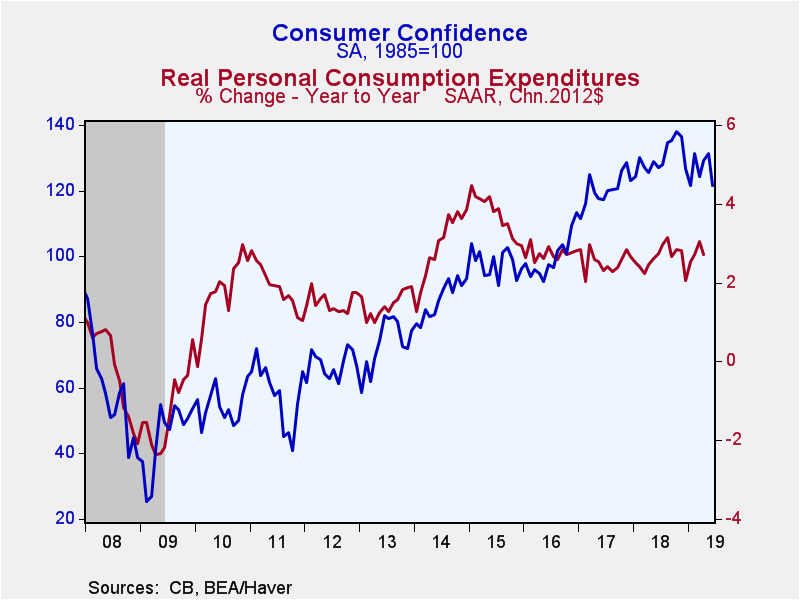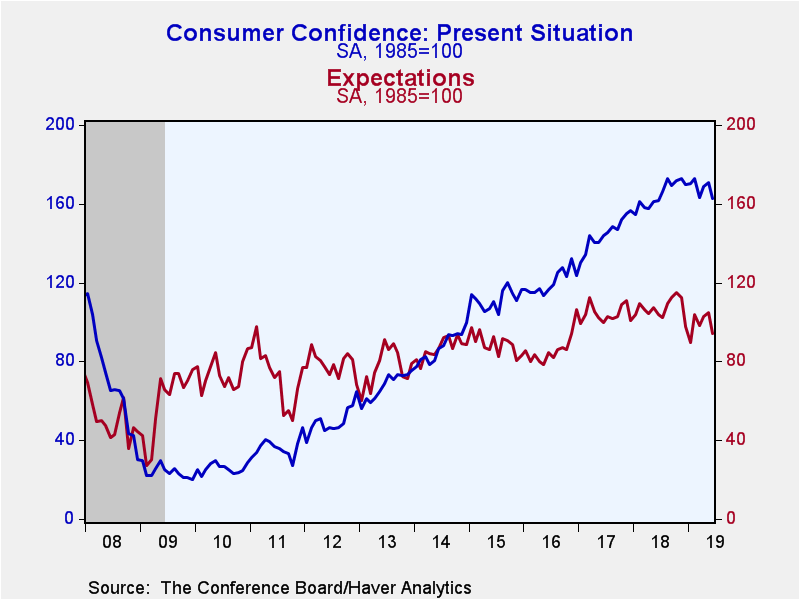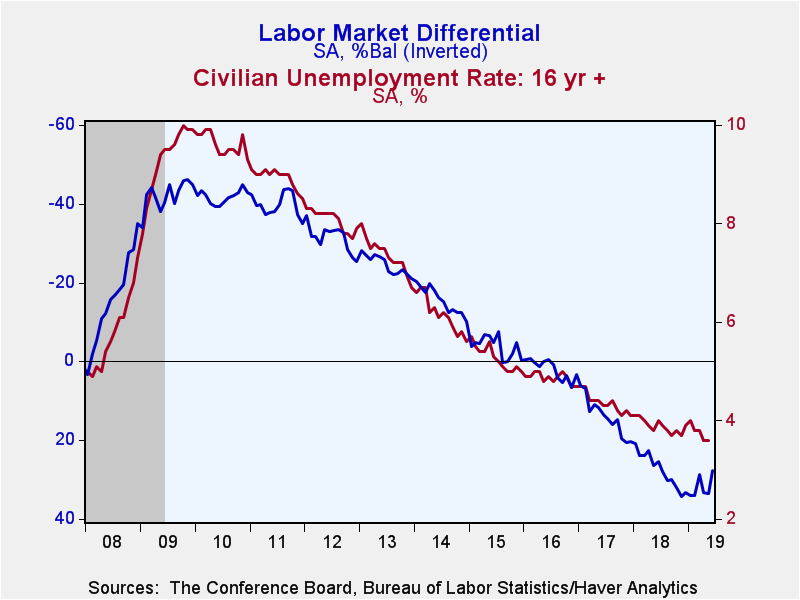 Global| Jun 25 2019
Global| Jun 25 2019U.S. Consumer Confidence Drops
Summary
The Conference Board Consumer Confidence Index fell a great-than-expected 7.5% to 121.5 in June (-4.4% year-on-year), from a downwardly revised 131.3 in May (was 134.1). This is the lowest reading since September 2017 and well below [...]
The Conference Board Consumer Confidence Index fell a great-than-expected 7.5% to 121.5 in June (-4.4% year-on-year), from a downwardly revised 131.3 in May (was 134.1). This is the lowest reading since September 2017 and well below the Action Economics Forecast Survey forecast of 131.9. During the past ten years, there has been a 59% correlation between the level of consumer confidence and the year-on-year change in monthly real consumer spending.
Consumer views of the current situation and expectations both dimmed in June, with the present situation down 4.7% to 162.6 (+0.6% y/y) and expectations dropping 10.4% to 94.1 (-9.5% y/y). The labor market differential, representing the difference between respondents indicating 'jobs are plentiful' and those saying 'jobs are hard to get', declined to 27.6% the lowest reading in a year. This series has a 97% correlation with the unemployment rate over the last ten years. The decline in the jobs gap was primarily the result of a jump in the 'jobs hard to get' measure to its highest rate in almost two years.
Interestingly, despite soft inflation readings, the expected inflation rate in twelve months rose to 5.1%, the fastest since October 2015. The share of respondents planning on buying a new home in six-months increased to 6.8% in June. Meanwhile, those planning on buying a major appliance slid to 46.6%, the lowest reading in four-and-a-half years.
Confidence fell for all demographic groups, led by an 11.8% drop for those 55 years and over. Over the last year the confidence of those under 35 has fallen 11.3%.
The Consumer Confidence data are available in Haver's CBDB database. The total indexes, which are indexed to 1985=100, appear in USECON, and the market expectations are in AS1REPNA.
Economic Outlook and Monetary Policy Review from Federal Reserve Chairman Jerome H. Powell is available here.
| Conference Board (SA, 1985=100) | Jun | May | Apr | Jun Y/Y % | 2018 | 2017 | 2016 |
|---|---|---|---|---|---|---|---|
| Consumer Confidence Index | 121.5 | 131.3 | 129.2 | -4.4 | 130.1 | 120.5 | 99.8 |
| Present Situation | 162.6 | 170.7 | 169.0 | 0.6 | 164.8 | 144.8 | 120.3 |
| Expectations | 94.1 | 105.0 | 102.7 | -9.5 | 107.0 | 104.3 | 86.1 |
| Consumer Confidence By Age Group | 0.0 | 0.0 | 0.0 | 0.0 | 0.0 | 0.0 | 0.0 |
| Under 35 Years | 112.7 | 120.0 | 145.0 | -11.3 | 133.7 | 130.2 | 122.4 |
| Aged 35-54 Years | 131.2 | 135.1 | 133.1 | -0.6 | 132.2 | 123.5 | 106.2 |
| Over 55 Years | 116.9 | 132.5 | 119.8 | -4.8 | 126.3 | 112.9 | 84.6 |
Gerald D. Cohen
AuthorMore in Author Profile »Gerald Cohen provides strategic vision and leadership of the translational economic research and policy initiatives at the Kenan Institute of Private Enterprise.
He has worked in both the public and private sectors focusing on the intersection between financial markets and economic fundamentals. He was a Senior Economist at Haver Analytics from January 2019 to February 2021. During the Obama Administration Gerald was Deputy Assistant Secretary for Macroeconomic Analysis at the U.S. Department of Treasury where he helped formulate and evaluate the impact of policy proposals on the U.S. economy. Prior to Treasury, he co-managed a global macro fund at Ziff Brothers Investments.
Gerald holds a bachelor’s of science from the Massachusetts Institute of Technology and a Ph.D. in Economics from Harvard University and is a contributing author to 30-Second Money as well as a co-author of Political Cycles and the Macroeconomy.









